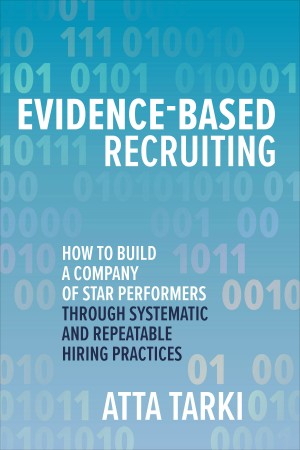’Create Your Own Feedback Loop — Today’: Atta Tarki Makes the Case for ’Evidence-Based Recruiting’

Not many recruiters have master’s degrees in economics — but maybe more of them should.
See, for example, Atta Tarki, the CEO of project staffing and executive search firm ECA Partners and author of Evidence-Based Recruiting: How to Build a Company of Star Performers Through Systematic and Repeatable Hiring Practices.
In Evidence-Based Recruiting, Tarki makes the case that, for far too long, recruiting has been dominated by intuition. If companies want to get serious about attracting and retaining the best and the brightest, they need to start putting analytics first in the talent acquisition equation.
You’ve likely heard that sentiment before, but Tarki approaches his subject with significantly more rigor than most. He doesn’t simply make the argument for data’s value — he also offers a clear, practical plan for how talent acquisition teams can finally walk the walk in the age of people analytics.
Below, Tarki chats with Recruiter.com about what evidence-based recruiting is, why hiring managers should stop worrying about “solid performers,” and the crucial difference between strategy and execution.
Recruiter.com: Let’s start with that title:Evidence-Based Recruiting. In a nutshell, what is “evidence-based recruiting,” and what sets it apart from other forms of recruiting?
Atta Tarki (AT): I would argue that most approaches to recruiting today are based on intuition and old industry practices. Three-quarters of organizations don’t even try to measure the quality of their hires — but if you don’t measure the quality of your hires, then how are you going to measure which hiring techniques are more effective in predicting job performance?
Evidence-based recruiting allows companies to improve their recruiting results by first defining what specific metrics they want to improve and how they can measure success for those metrics. From there, companies record hiring data and continuously improve their recruiting results through a more fact-based approach. It starts with designing your entire hiring process based on objective data about what has worked in the past. An evidence-based approach is also hypothesis-driven, meaning you will change your approach if the data shows your methods are not working.
I’m not suggesting the power of intuition be completely dismissed. However, hiring managers can make more effective decisions by relying on a more balanced mixture of quantitative and qualitative information. Marketing transitioned from one of the most intuitive fields in business some 20 years ago to one of the most data-driven fields today. More organizations need to make a similar transition for recruiting.

AT: What most hiring managers mean by “solid” performers is “slightly-above-average” performers. I don’t have anything against the hypothesis that solid performers create most of the value in an organization — it just happens that this hypothesis is not true.
It is true that solid performers do most of the activities, because most organizations have more solid performers than star performers. However, the bulk of the value in most organizations is created by star performers.
Did you know that, out of 24,000 tennis players in the Association of Tennis Professionals, the top 10 collect 98 percent of the total prize money? Similarly, a star programmer is unlikely to write 100 times more code than someone who is just slightly above average, but the quality of the code a star programmer writes could be a game changer. This is how Google has been able to consistently beat out rival search engines like AltaVista, Yahoo, and Bing — by making sure the best people are working for them and not their competitors.
RC: You stress the importance of creating “feedback loops” in talent acquisition. Can you describe what such a feedback loop might look like, and why it is important to evidence-based recruiting?
AT: You don’t improve what you don’t measure, but by taking an evidence-based approach, you can create a positive feedback loop. To do so, you only need to apply these four simple steps:
- Use quantitative metrics to rate candidates when you interview them.
- Collect and store this data. This might seem easy, but most organizations struggle with this step unless they have someone specifically charged with doing the collecting and storing.
- Define on-the-job-performance and collect data on it.
- Analyze the data for recent hires to see what data points in your interviews were most helpful in predicting on-the-job success.
Leading companies like Amazon have already created this kind of feedback loop for their recruiting, and so should anyone who wants recruiting to play a central role in building the kind of extraordinary teams that produce extraordinary results.
RC: In your book, you write, “Most often, it is not a company’s recruiting strategy that sets it apart. It’s the company’s ability and discipline to execute upon strategy that is the real differentiator.” Can you say more about that?
AT: I don’t know of any company that sets out to recruit subpar performers. Rather, most companies claim that their people are their greatest asset. They typically say things like, “Hiring and retaining great people is our priority,” or, “Our employees are the true force behind our success.”
These statements were made by Frontier Communications and Sears. Those companies have one thing in common: Based on Glassdoor ratings and reviews, both organizations have landed on 24/7 Wall St.’s prestigious “Worst Companies to Work For” list.
If a company’s employees really are its biggest asset and most important driver of success, shouldn’t the company focus more resources on improving talent acquisition processes and employee satisfaction?
A good recruiting strategy can be useful in outlining aspirational results, but it is the company’s ability and discipline to execute against that strategy that create realresults. This is not much different from understanding who wants to work hard in order to get in good shape. Everyone checks that box. It’s much more important to understand who has the willpower to consistently follow through on that aspiration. This sets the individuals who achieve actual results apart from those who are “determined” to achieve results. Some day. Eventually.
For more expert HR insights, check out the latest issue of Recruiter.com Magazine:
RC: You introduce the concepts of “strong” and “weak” evidence in recruiting. Could you say a little more about what constitutes “strong” evidence and what constitutes “weak” evidence?
AT: The best evidence is objective and can be easily verified. This type of evidence is often referred to as “hard facts” or “strong” evidence. For instance, it would be easy for the Wall Street Journal to confirm if Kevin Durant really is 6’9”, as his official NBA records claim he is, or 6’11”, as the Wall Street Journal claims he is. As long as Durant agrees to it, the Journal can settle the issue once and for all by measuring him.
Why would Durant want to be perceived as shorter than he is? The Wall Street Journal didn’t have to measure him. Durant himself admitted in an interview with the paper, “Really, that’s the prototypical size for a small forward. Anything taller than that, and they’ll start saying, ‘Ah, he’s a power forward.'”
Job applicants are not usually so naive as to mislead employers about hard facts. The real challenge arises when trying to assess facts that are not as straightforward or easy to confirm. Take, for instance, Christian Eberhard, who was employed as a medical doctor by the University Clinic of Erlangen in Germany. He took part in 190 operations and surgeries, including amputations. What the university clinic didn’t know was that Eberhard had faked his medical degree. The clinic could have found out if it had called Oxford University, where Eberhard claimed to have earned his degree. Today, we could even use social media to look up people who attended the same university and reach out to see if anyone could verify the information.
Even though the evidence presented by Eberhard (a fake diploma) was possible to verify, it was somewhat difficult for the German university clinic to do so. No one was familiar with the British system, and therefore they did not want to invest the time to verify the information. The evidence Eberhard presented that he was a doctor should have been treated as “medium-strong.” The information, or evidence, was somewhat verifiable but cumbersome to verify.
Then we have “Jennifer.” Jennifer was a very likable talent acquisition executive with one of the companies we work with. She had charmed the CEO and COO of this billion-dollar company during her interviews. She also interviewed with, and charmed, all six talent acquisition professionals who would report to her in her new position.
The company had repeatedly told Jennifer during the interview process that its style of management could best be described as “servant leadership.” To the company, this meant a friendly, collaborative, and nurturing leadership style. Jennifer seemed excited and energized by this description, and she had described in depth how this was a close match to her preferred style.
Within one week of Jennifer starting, the COO received multiple emails from talent acquisition team members saying they would most likely leave the company if Jennifer did not change her style. The emails described how she had yelled at them, spoke to them in a demeaning tone, and humiliated team members in front of the group. She was brought in for an open conversation with the COO and given a clear warning. On the first day of her third week, Jennifer was let go.
Many people can be charming during a job interview. Being charming in real life, even when a job depends on it, can be harder. A candidate’s charm during an interview is thus “weak” evidence of how charming they will be on the job. This is also referred to as “soft” evidence. It is the opposite of hard evidence, which can be verified more easily.
Unfortunately, most of the evidence from an interview is soft evidence. The best way to verify soft evidence is to obtain multiple data points from several angles trying to assess the same trait. This requires some planning and concerted effort, but the alternative is to keep using the same interview techniques as you have in the past and expecting different results going forward.
RC: If there were one lesson you wanted readers to walk away from this book with, what would it be?
AT: Create your own feedback loop. Today.
Companies are using more and more sophisticated interview and candidate evaluation techniques. The average length of the interview process has nearly doubled over the past few years. It’s great that companies are taking candidate evaluation more seriously, but it’s meaningless if you don’t check to see whether all that added complexity is helping you become better at predicting candidates’ on-the-job success. As I mentioned earlier, less than a quarter of companies measure the effectiveness of their hiring techniques.
Adding new methods without measuring their effectiveness is unlikely to help you achieve better hiring results. Successful hiring managers don’t confuse precision with accuracy, and you can’t improve the accuracy of your hiring methods if you don’t measure what’s working.

